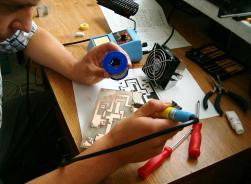Categories: Sharing experience, Repair of household appliances
Number of views: 37956
Comments on the article: 5
How to repair electrical appliances
 Your household appliances, faithfully served before that suddenly stopped working? If we are talking about something inexpensive (a radio, a hairdryer, an electric kettle, a phone charger), then you have a choice - go buy a new one, or try to reanimate household electrical appliance in the home.
Your household appliances, faithfully served before that suddenly stopped working? If we are talking about something inexpensive (a radio, a hairdryer, an electric kettle, a phone charger), then you have a choice - go buy a new one, or try to reanimate household electrical appliance in the home.
For all the pros and cons of both options, read this article: What to do with a broken household appliance?
Trying to repair a broken household appliance is definitely worth it, because it will not be any worse, and extra money does not happen in principle. To begin with, you should arm yourself with a minimal gentleman's set consisting of a screwdriver, pliers, a multimeter and soldering iron.
Whatever you repair, everything will happen according to the same scheme, consisting of the following steps.
Opening a faulty appliance. Use a screwdriver of suitable length and width to unscrew the screws that connect the case. It’s good if there is a place nearby where to put them, because the screws are very fond of getting lost or falling to the floor. be careful - Chinese comrades love to place fasteners in hard-to-reach places, so do not rush to use force if the case does not open after all the screws are unscrewed.
Electrical Appliance Diagnostics. In good lighting, carefully inspect the inside of the appliance for broken wires, broken boards, charred elements, or swollen capacitors. As a rule, a visual inspection reveals a problem. For example, the same hair dryers often stop working due to the fact that the hair is wound around the fan and repair of the hair dryer can only consist in disassembling and cleaning it.
If it comes about power cordsfusible fuses and heating elements, a multimeter is indispensable for their diagnosis. In a broken core of a cord, a blown fuse or a blown spiral of a heating element, the resistance will be infinite. It is also very convenient to check the batteries and accumulators with a multimeter, since their status is immediately visible.
Multimeter (tester) - universal measuring device and the most important measuring electrician tool. You can get the basic skills of using a multimeter and the principles of measuring the electrical characteristics of various components of household electrical appliances with the help of this article:
A multimeter for dummies: the basic principles of measuring with a multimeter
An example of using a multimeter to check the performance of capacitors: How to identify a faulty capacitor.
The most common malfunctions in electrical circuits of electrical appliances and household appliances, as well as the troubleshooting algorithm in household electrical appliances is discussed in detail in these articles:
Useful troubleshooting tips for repairing electrical equipment
Using the block-sequential method for troubleshooting electrical circuits.
If all the details are intact and workable, and the problem is that something has come off, then you are lucky - solder back and everything works. If not, then go to the next item.
Replacing electrical parts. When an inoperative element is identified, consider the likelihood of finding the same, but serviceable. If some exclusive microcircuit fails, then the game is not worth the candle and there is only one way for such a device - to a landfill.
If a conventional resistor, capacitor or heater burns out, then you can try to look for it on the radio market or in a store. Rewrite its parameters, and if it does not take much time and effort, try to find. Do not forget to weigh the cost of the part and the new device, since if they are approximately equal, then the repair makes no sense.
There should be no problems with soldering - this is a fairly simple operation, even with a minimum of experience. About equipment and tools for soldering, about how to correctly five and what fluxes and solders are used for soldering, see here:
Devices and tools for soldering
Assembling a repaired electrical appliance. Well, it’s easy if you remember how to disassemble. Be sure to check that there are no extra parts left. Believe that the designers of the device are not fools, and in fact, these details are not even superfluous. Have you checked? Has it earned? Well, you can be congratulated!
Specific troubleshooting and repair recommendations:
How to repair an extension cord
How to repair a New Year's garland
DIY computer power supply repair
When repairing electrical appliances, be sure to observe the electrical safety rules!
And what if the household appliance could not be repaired? On the one hand, it is not worth littering the dwelling, on the other, there is a possibility that the parts from this appliance will be useful in the next repairs. Therefore, if you have free space in your apartment, then you can organize an improvised warehouse of spare parts.
See also at e.imadeself.com
:
